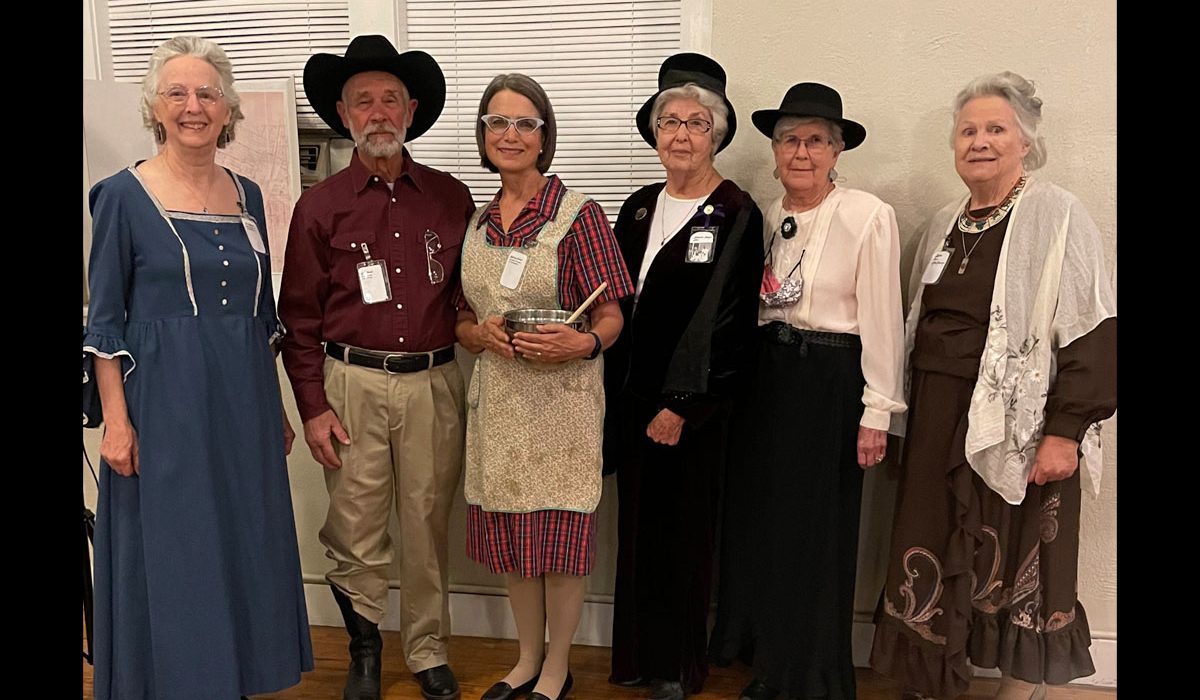Caddo hosts first Sesquicentennial event of many in yearlong celebration
By Vesta Baker
“Trails, Streets and Roads of Caddo,” was the topic for Caddo’s first Sesquicentennial event, held Monday, Jan. 17, 2022, at the Rock Community Building. The audience was welcomed by the hostess for the evening, Vesta Baker, who also contributed the first segment of the program. The Sesquicentennial logo was revealed, and tee shirts were on sale.
The theme of the Sesquicentennial is “Tradition Makes the Future,” and audience members were reminded that whether we have lived here for a lifetime or recently arrived, we will all be a part of somebody else’s history.
In her research, Vesta observed that many influential pioneers of Caddo were devout Christians, ministers, missionaries, and church founders. In their honor, she began the program by reading a verse from the Bible, Hebrews 12:1. “Therefore, since we are surrounded by such a great cloud of witnesses, let us throw off everything that hinders and the sin that so easily entangles, and let us run with perseverance the race marked out for us.”
The audience was urged to envision the people who built the community, being our “cloud of witnesses,” looking over our shoulders to see if we are following the paths, they marked out for us. Local volunteers mingled with the crowd, dressed in costume, to represent some of the leading citizens of Caddo history.
Vesta’s presentation began with a description of two significant trails that were important to Caddo history: the Texas Trail and a buffalo trail. Some of Caddo’s earliest pioneers were attracted to land that was near the Texas Trail, which afforded them contact with settlers passing through, from Missouri and Kansas, to claim free land in Texas. The wagon trains kept them in touch with the rest of the world, as well as offering opportunities to trade with the settlers.
Later on, those settlers raised herds of beef cattle, and profited greatly from that same trail, carved by the horses’ hooves and wagon wheels of travelers. The Texas Trail was sometimes called the Texas Road, or the Shawnee Trail, when Texans began to drive cattle north to stockyards in Missouri and Nebraska.
The Choctaw Nation divided up their land into counties, and established the area as Blue County. The Nation recognized the value of the community that had sprung up on a buffalo trail, and in the 1870s Caddo was named as the county seat. That buffalo trail was named Buffalo Street when the town was officially established.
Small town citizens often depend on history, rather than street names, to find their way around, and people of Caddo are no exception. It seems easier to describe where they live by telling whose house it used to be, or who lives across the street from them. Hearing stories about Caddo’s prominent early residents brought to life the reasons for some of the names of streets and roads. Many of the families moved away, after leaving their mark on the community, with no remaining descendants to continue their legacy. Unfortunately, unless the stories of those inspiring residents are retold, the younger generation will miss the rich significance of those street names.
The many colorful historical figures mentioned in Vesta’s presentation included one of Roosevelt’s Roughriders, and a WWII fallen hero, inspiring us to be good Americans. Caddo can boast of having the first woman editor of a newspaper in Oklahoma, who later moved to Texas and was the first woman editor in Texas. Her boldness to excel in a profession dominated by men, inspires all of us to have lofty goals. Avenues and roads are named for businessmen, bankers, doctors, community organizers, and ranchers who worked diligently to bring prosperity to not only themselves, but to help their neighbors to thrive. They have marked the path for us to follow, with diligence and resourcefulness. Some were lawyers, judges, and peacekeepers, who protected and brought order to the developing town. They were men and women who used their talents as well as their wealth in noble causes, challenging us to be generous.
Caddo High School students had researched early transportation in their computer class, and produced a brochure, to give to attendees. Students made oral presentations, along with a PowerPoint presentation, highlighting the Butterfield Stage Line, which provided an important mail service from 1857 to 1861. Nails Crossing, which included lodging and a toll bridge, was registered as a historic landmark in 1958. Nail’s Crossing lost its popularity when the Missouri Kansas & Texas Railroad made Caddo a shipping and trade center. Caddo became recognized as a town, as a result of the MKT completing the line to Caddo Station in 1872.
A short intermission gave the audience members an opportunity to chat with the “visitors from the past,” and make new acquaintances, as well as enjoy refreshments, and sign up for an attendance prize. They viewed historic photos and a copy of the original map of the town, made by the Department of the Interior in 1901. They also had a chance to get acquainted with Roger Bell, President of the Jefferson Highway Association, and look over materials he displayed, about the JH.
The second half of the program was presented by Roger Bell, who has been a Jefferson Highway enthusiast for many years. He gave an overview of why historic roads are significant for today’s culture, and what attracts people to travel old roads. The Jefferson Highway was constructed during the years 1915 to 1916, made possible by the cooperation and personal investments of individual communities, not funded by state or federal government. An early Caddo community leader, W.F. Dodd, was among 50 Oklahoma representatives who convened in New Orleans to promote their cause, to bring the transcontinental road through their communities.
Roger presented an enlightening overview of the establishment of this outstanding highway, nicknamed the “Pine to Palm Highway, from Winnipeg, Canada, to New Orleans. He shared that trends in tourism are indicating a growing interest, even among international tourists, in traveling old roads to experience a taste of classic Americana. Travelers frequently tell Roger that Caddo is an especially memorable part of their journey down the JH. The audience was amazed to see the history of Caddo so prominently included in the presentation, and happy to hear that the Jefferson Highway, which includes Caddo’s Main Street, has now been declared an Oklahoma historic route, by Governor Stitt.
Readers are invited to join in the next Sesquicentennial event, Monday, Feb. 21, from 6-8 p.m., at the Rock Community Building. The presentations for the evening will cover two topics: The History of Caddo Schools and the Caddo Corn Carnival. Caddo High School English students will bring a report on the history of Caddo’s famous Corn Carnival. The annual festival was quite an elaborate production, and attracted thousands of visitors from all over Oklahoma and other neighboring states. Drama students will entertain the audience by performing an original skit/reenactment of an aspect of the carnival.
In honor of children of the past, the public is invited to bring antique toys, 30 years or older, to display during the event. Interested persons may contact the event planners by media below, to arrange for toys to be collected before the date, if they so desire. To add to the festivities, event goers are all encouraged to come in costume, of any decade, from 1872 to 1972. Questions or comments may be sent via email to civcem.caddo@yahoo.com or by text or call 580 367-0358.



2 Comments
I Love it and enjoyed many years in Caddo, growing up. I attended the old grade school and the old high school. Our teachers were like relatives teaching by book, word and example.. Saturday night was special when we all went downtown and the stores stayed open late.
ViP порно фильмы бесплатно смотреть на https://porno-go.website в HD1080
Из домашних архивов порно ролики для взрослых просмотр на https://porno-go.ru в HD1080
Из домашних архивов секс запись без границ смотреть на https://porno-go.top в HD720
Из домашних архивов порно запись для взрослых смотреть на https://porno-go.pro в HD1080
Из домашних архивов секс съемка без регистрации смотреть на https://porno-go.mobi в HD1080
.